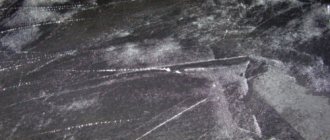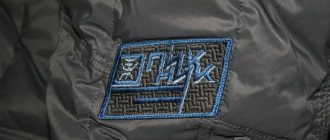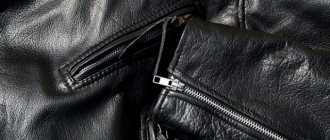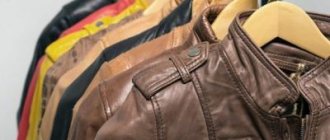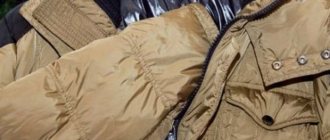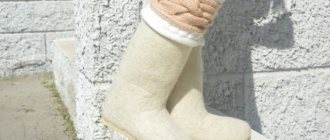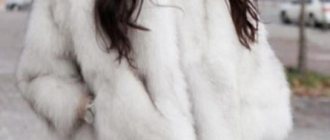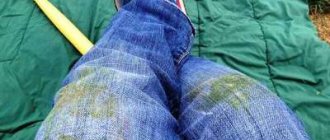Advice! To prevent a wet leatherette jacket from deforming, you should dry it at room temperature.
Polyester
Polyester is a synthetic fabric that has much in common with bologna, so the methods for ironing a polyester jacket are similar to the methods for ironing a bologna jacket. You can add just a few features and tricks for each method.
A polyester jacket (with or without padding) will not need to be ironed after washing if the drying conditions are met. Drying the product after washing is carried out as follows:
- squeeze out excess moisture by pressing with your hands and without twisting the product;
- blot particularly wet areas with a terry towel;
- hang the product on hangers in the room.
The resulting wrinkles can be straightened out by hand while the jacket is drying on a hanger. You can also stuff the sleeves of the product with paper to straighten the fabric (relevant for demi-season jackets without padding or lining). After such drying, ironing will most likely not be necessary.
It is better to steam a synthetic jacket. To do this, you can use an iron that is set to steam mode at the minimum temperature. Steaming instructions include the following steps:
- hang the jacket on hangers;
- bring the iron to the product at a distance of 2-3 cm (the higher the temperature of the device, the greater the distance) and release steam;
- process the entire length of the clothing, releasing steam and moving the iron without touching the fabric from top to bottom.
As a rule, the back is steamed first, then the sleeves, shoulders and fronts.
With an iron, polyester, like bologna, is ironed through the fabric. You can fold the gauze into 4 layers or use a damp towel. If it is impossible to place fabric, then the iron must be set to the minimum temperature. Ironing is carried out from the wrong side. If after ironing there are still folds left, you can iron it from the front side, but you must control the heating temperature of the iron.
We store it correctly
Often, ironing a jacket is not necessary if storage rules are followed. Creases and small folds often form due to improper care and maintenance of the product. In order not to think about how to iron a jacket with your own hands, you need to follow a few simple rules for storing things.
How to properly store a jacket:
- leave in the closet only on hangers, having first straightened all the folds;
- fasten all zippers and buttons;
- if it is impossible to store the jacket hanging, then you need to fold it (like a shirt) and roll it;
- To prevent clothes from becoming covered in dust, it is recommended to store them in a cover;
- before putting the jacket in the closet, it must be cleaned;
- Only completely dry products should be stored.
These simple rules will help not only maintain the shape of the jacket, but also extend its service life.
The video in this article will clearly demonstrate how to iron a wrinkled jacket.
As you can see, a jacket made of any material can be ironed at home. The main thing is not to overdo it and not end up with stains and holes on your favorite item. If the housewife still has doubts and does not want to take risks, then all that remains is to turn to laundry specialists for help.
A fashionable coat doesn't have to be practical.
Modern fashionistas often prefer stylish polyester and suede to unpretentious drape, cloth, solid boucle or coat fabric.
You not only need to know how to care for popular synthetic or natural leather outerwear, but also how to iron coats made from tricky fabrics at home.
Read in this article:
- Tips for ironing suede items
- Ironing polyester
- How to steam a coat?
- How to iron a suede and polyester coat without an iron?
Recommendations for using shoes
To avoid the need to regularly remove creases from shoes, you need to handle them carefully and follow the recommendations:
- You should choose a pair that fits in size. If the shoes are too wide, then creases will appear in the widest places. The leather on shoes that are too narrow will begin to break due to excessive tension.
- May only be worn during the appropriate season. Summer sandals can easily withstand heavy rain, but wearing them into the water on vacation is unacceptable.
- It is necessary to use creams and impregnations that match the color and qualities of the material. For smooth, patent leather, nubuck, and suede, special products are needed.
- It is recommended to wear shoes with clasps and clasps undone. If necessary, use a spoon. Do not trample the heel and step on it to remove the boots.
- Dress shoes made from delicate materials are intended for indoor use. You can wear it at work, at a festive event, or at a party. It is best to change your shoes before going outside.
- It is necessary to purchase several pairs of seasonal shoes and alternate them, since shoes and boots need rest. They do not dry out overnight and do not have time to take their original shape.
- When washing, do not completely expose it to running water. It is better to use different sponges to wash the sole and top of the product.
- You should not wear damp or damp shoes, as the leather in this state becomes stretched and deformed.
- In winter and the rainy season, it is necessary to use special waterproof compounds for treating leather. If insoles get wet, dry them separately from your shoes to prevent the leather from becoming damp.
Important! It is not recommended to use aggressive detergents, including soap, to clean leather shoes. These drugs contribute to premature aging of the material and the formation of folds and cracks.
If you follow the right tips and recommendations for caring for boots made from natural materials, and also follow the appropriate cleaning conditions, you can forget about how to remove creases from shoes.
How to iron a suede coat?
Aristocratic suede looks great on the figure, drapes perfectly, but is not at all practical and wrinkles quite easily. You need to look after her extremely carefully. A coat made of polyester does not require such close attention: this material is durable, washes and dries well, and practically does not fade. But if it is wrinkled, it will not be easy to straighten out the creases. That is why you need to know how to iron a coat at home with and without an iron, so as not to spoil the product made of suede and polyester.
Natural suede is difficult to care for, since the leather of this type has the finest lint. Is it possible to iron a suede coat? It all depends on the thickness of the leather, the delicacy of the workmanship, and the color of the material. Dense material withstands rough heat treatment best, but you also need to be very careful with it.
You can try ironing a suede coat. But first you should make sure that this type of processing will not destroy the product. If there is a piece of leather left (many manufacturers sew it from the inside out), you need to try ironing on it. How to carry out work safely? If you decide to iron out wrinkles on outerwear yourself using an iron, you need to follow these general recommendations:
- heat the iron to the minimum temperature (for each model it is indicated accordingly);
- Place the coat on the ironing board with the right side down (you only need to iron it from the inside out). Use your hands to straighten the fold we will be working with;
- Place a piece of silk fabric (iron) on top of the suede fold;
- iron the coat, carefully moving the surface of the iron over the treatment area.
Some types of suede tolerate ironing well from the front side, and at higher temperatures. You can try ironing the material, but there are two prerequisites: use silk cloth as gauze and, if possible, turn off the steamer.
After ironing, the suede pile will be compressed, so the ironed surface of the coat will look shiny. Therefore, in any case, after ironing, you need to straighten the crushed pile by combing it with a rubber or hard hair brush. You can buy this, for example, in shoe stores.
To iron clothes quickly and safely for the fabric, you will have to clean the iron from carbon deposits and scale. Our article will tell you which products are best to use for cleaning.
Here you will find all the tips on choosing an ironing board, the quality of which largely determines the quality of ironing. Just read the article and follow the tips described in it.
If, after ironing, a seam mark is imprinted on the coat, it can be “erased” with a regular eraser. Be sure to make sure that its rubber surface does not stain the skin or leave marks!
What is possible and what is not?
When ironing your jacket, you must adhere to the following recommendations:
Before ironing, check the composition of the fabric.- If you are in doubt about the ironing temperature, you should start with the minimum temperature, increasing it gradually.
- It is forbidden to iron the product from the front side.
- During exposure to a steam generator, iron or steamer, you should not adjust the item to avoid getting a thermal burn.
- Do not increase the heating temperature higher than indicated on the product label.
- You cannot put on an item after ironing until it has cooled down.
How to steam a coat without ironing?
You can smooth almost any woven or leather surface without direct ironing. However, in this case, the iron must have a vertical steam function.
How to use a steamer when ironing? Very simple.
Steaming allows you to rid polyester items of unpleasant lingering odors. Hot steam also removes stains and stains and returns the products to neatness, neatness, and a pleasant appearance. A common problem with household irons is their tendency to suddenly “spit out” particles of dirt and dirty wet steam when steaming. If this happens to your iron, it makes sense to abandon this method of processing your coat, especially if it is light in color.
Jeans are considered the most favorite clothing for men, women, children, in general, everyone. Let's learn how to iron jeans without ruining your favorite pants.
And here you will find tips on ironing trousers made of different fabrics. Our article will allow you to learn all the subtleties and nuances of ironing delicate materials with and without an iron.
How to remove wrinkles from leather shoes in a simple way
When a person likes his shoes or sneakers, even a small crease in them that cannot be straightened out can cause frustration. Sooner or later everyone has to deal with this. Let's look at one way to remove wrinkles and creases.
Important : to iron leatherette, which is essentially the same leatherette, the cotton mode may be too hot. It’s better to turn down the power a little with the thermostat wheel.
What is needed for this
- iron with steam function;
- small towels;
- ironing board or table;
- backing fabric;
- water.
Instructions
- Make thick rollers out of paper and cardboard and secure them with tape. They should follow the shape of the sole as much as possible - this way you can achieve the greatest effect.
- Insert the inserts into the shoes so that they fit tightly into the space under the area where wrinkles accumulate. You can smooth out sneakers or boots using the same method: the main thing is that the shoes retain their shape as much as possible in the area of the foot and the curve of the head.
- Place the pair to be restored on a table or ironing board, having previously covered the backing, and cover the head with a towel (it should only be made of natural fabric).
- Plug in the iron, setting the thermostat to o or to the position that you use for such fabric. When the sole is warm, begin stroking the surface of the head as you would a wrinkled shirt or trousers - without much effort. You can straighten the material only if the “steam” function is turned on, but your electrical appliance may not have it. In such a situation, there is a simple way out - generously sprinkle a towel, through which you will begin to straighten wrinkles.
- When you finish the procedure, do not rush to pull out the earbuds and remove the protective material. Wait until the shoes cool down completely so that you don’t feel any heat under your palm—this is a necessary condition.
- Treat the surface with shoe polish and you will be able to enjoy the results of your labor for a long time.
How to iron a polyester or suede coat without an iron - tips
If the iron has a bad temper and “spits” dirty steam”; if you are afraid to iron a delicate polyester or suede coat on a hot surface; If you simply don’t have an iron at hand, then you can iron your outerwear in the old, proven way. To understand how to iron a coat without an iron, you just need to remember the ability of moist, warm steam to make fabric fibers heavier.
It turns out that you can iron a suede coat or polyester outerwear without the usual household appliance. It's quite easy to do and gives excellent results.
- Fill the bath with hot water by closing the bathroom door tightly and letting in the hottest water. To be sure, you can pour a kettle of boiling water into the manna.
- Hang polyester or suede coats on a suitable hanger.
- The buttons of the product must be fastened.
- The coat hanger should be placed above the bathtub, having thought through the reliability of the design.
- The coat should spend several hours in the “steam room” so that the wet steam saturates the fibers of the fabric and straightens out every wrinkle.
- When the water in the bath has cooled and all the folds have straightened, you need to move the products into the room and leave them until completely dry.
Important! When drying a coat smoothed in this way, it should not be placed near a radiator or in direct sunlight. The product should dry at natural room temperature.
